- Home Test 625
- Home
- Visit
- Exhibits
- Programs & Events
- Membership
- Support
- Give the Gift of Play
- About
- Checkout
- Cart
- Utility
- Birthday Party Cancellation Form
- Phone Call
- Request for a Facility Rental Agreement
- Privacy Policy
- American Girl Benefit Sale
- Party Catering Form
- Event Date Request Form
- Camp Food Orders
- Flourish!
- IA24 Evening Event RSVP
- Development Events RSVP
- Development Tour
- Folder Request Form
- Development Team Test Page
- Logout
- Birthday Parties
Access matters: How rethinking low-cost memberships promoted inclusion and boosted visits at the Madison Children’s Museum
The Capital Times
BY NATALIE YAHR
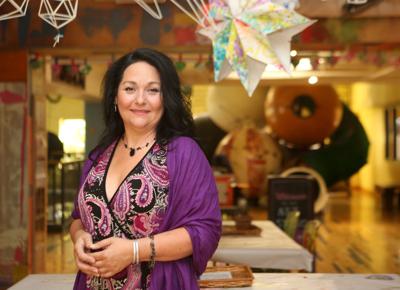
Sandra Bonnici, associate director of education, diversity and inclusion is pictured at the Madison Children’s Museum in Madison.
About four years ago, staff at the Madison Children’s Museum took a risk.
For years the museum had required families to present documentation — proving, for example, that they receive food stamps or that their children have special needs — in order to receive discounted “Access for Everyone” admission and membership rates. Ignoring warnings from others in their field, the museum stopped asking for proof.
Sandra Bonnici, who spent her first 10 years at the museum leading outreach, said the “poverty shaming” was counterproductive.
“We were making all these efforts to get people to our door and then having to do the gauntlet of shame with their children once they’re through the door,” said Bonnici, who is now the museum’s associate director of education, diversity and inclusion. “Even though these programs are designed to eliminate financial barriers, the way we were implementing them was actually in itself a barrier.”
The risk paid off. The museum’s Access membership numbers rose, and full-price memberships did not decline as some had feared.
“There’s this myth of the programs being abused,” Bonnici said. “We weren’t run over. They didn’t storm the castle. Yes, we saw an increase in usage — that we wanted to see — but we weren’t overwhelmed and we didn’t implode.”
While some organizations have to collect this documentation in order to receive a government subsidy, Bonnici said, “the reality for us is that we don’t.” The move raised doubts among other cultural institutions, but Bonnici wasn’t worried. “Sometimes standard practice is not best practice,” she said.
The museum had previously seen a decline in its number of Access for Everyone memberships, which Bonnici attributed, in part, to a change in public attitudes.
“The tone and tenor around poverty and our assistance has gotten more deeply negative,” Bonnici said.
She worried people might pass up visiting the museum to avoid feeling singled out in front of their children. And when state legislation removed tens of thousands of people from the food stamp rolls in 2015, some families lost the most commonly used form of proof.
“So we were kind of putting data points together and (thinking), ‘OK, this is really getting in the way,’” she said.
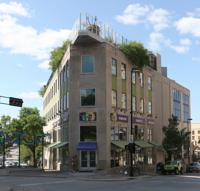
The business case for inclusion
One big mark of success, Bonnici said, was that Access members visited the museum more often — 84% more in fiscal year 2017-2018 than in 2015-2016 — while visits by all members rose 35%, according to museum figures. In 2017-2018, free and reduced price admissions accounted for over 45,000 visits, and nearly 1,300 families purchased discounted Access memberships, which start at $15 per family per year.
“Anyone can come one time, and if something is low-cost, there isn’t a huge amount of investment,” Bonnici said. “But in order to have people come back, again and again and again, you have to have something of value, and you have to be a space that is welcoming and trusted.”
“Financially, it actually worked out to our benefit,” Bonnici said, noting that funders and donors who want the museum to be “essential to (its) community” stepped up their contributions because of the museum’s efforts to increase access.
“There’s the business case for this, and there’s the moral case,” Bonnici said. “This isn’t a finite resource. And when we’re trying to make the case for expansion or growth or even sustainability, I think we really need to understand that people need to be in the building.”
‘He feels like he owns the place’
Reduced prices are available to families of children with special needs, families that qualify for various types of public programs —including childcare subsidies, free/reduced school lunch, Medicaid, unemployment, Section 8 and Headstart —and those who participate in the YWCA, foster care, MMSD Play & Learn, or the School Age Parent Program run collaboratively by the museum and the Madison Metropolitan School District. Qualifying families can visit the museum for $1 per person or purchase discounted annual memberships for $15 to $50 based on what they say they can afford.
Visitors check a box on the membership form to indicate which of the 20 eligible programs they qualify for, and museum takes their word for it.
Additionally, the museum offers free admission to first-time parent families until their children are 18 months old and holds “Free Family Nights” open to all on the first Wednesday of each month.
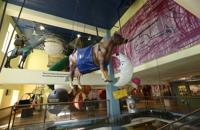
Roger, who asked to use only his first name due to privacy concerns, has benefited from these initiatives for years. Under the Birth to 3 program, Roger began bringing his baby son to the museum for just a dollar per person each time. Now his son is 7 and the family has an annual Access membership — which they qualify for because his son has an individualized education program, or IEP, at school — and Roger says they visit the museum most weekends.
Roger’s son has a rare chromosomal abnormality that causes him to fatigue quickly, but the reduced membership cost means his family doesn’t feel like they need to drag out their visits.
“We don’t ever feel the need to have to extend it past his threshold,” he said. “You have the tendency to stay a little bit longer than maybe is best for him if you’re paying full price every time.”
Roger said his son interacts more with other children there than he does in other public places, which Roger said shows that the musuem puts him at ease. It also allows for Roger’s son’s particular needs, providing a quiet, private space when his son needs to be fed through a feeding tube.
The museum staff also accommodate his son’s sillier needs, like the fact that he loves to have both of his hands stamped, not just one. “It’s a little thing, but he gets so excited about it,” Roger said. And when they saw that he was always pointing to their name tags, the staff made him his own name tag, complete with the museum logo.
“Things like that keep him at ease, and he feels like he owns the place when he walks in,” Roger said.
Beyond discounts
The museum just wrapped up its annual campaign to raise awareness about the Access programs among potential beneficiaries — and potential funders. The programs cost around $500,000 per year, said CEO Deb Gilpin.
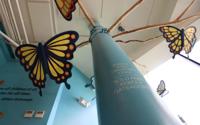
But Gilpin said drawing new visitors requires more than just reducing the cost. The museum must also teach potential visitors how the museum can benefit their children and let them know what to expect (“Are there going to be changing tables in the bathroom? Is there going to be food? How do I dress for this?”) She said the museum trains all staff on promoting inclusion and access.
Museum spokesman Jonathan Zarov said the Access programs are “a way of learning to better serve various communities” and figuring out what factors are keeping them from using the museum. “The ones people understand right away are the monetary barriers,” he said, but for the First-Time Parent program, “the largest barrier to address is probably the idea that babies are too young to benefit from a visit.”
The museum has also taken other steps to promote equity and inclusion. It hires and trains teenagers of color, holds monthly workshops for seniors with early onset Alzheimer’s and dementia, and designates “sensory-friendly” times — outside of the museum’s regular hours — in which staff alter various exhibit features to accommodate the needs of children with autism spectrum disorder and sensory issues.
‘A cultural shift’
The decision to stop asking for proof of eligibility is just one part of what Bonnici calls “a cultural shift” at the museum toward asking, “For whom do we exist?” She attributes the shift in part to the 2013 Race to Equity report, which highlighted racial disparities in Dane County.
“It showed in stark and horrifying detail things that most of us knew already,” Bonnici said. “It was incontrovertible data sets that said… ‘We can no longer not talk about this.’”
Seeking new ways to promote equity, staff requested input from local partner organizations, received racial justice workshops through the YWCA, and participated in a yearlong cultural competency training.
Promoting access is not a charity effort but a key step to “becoming a better and more inclusive institution, and therefore relevant,” Bonnici said. Museums across the country are facing questions about their relevance as the U.S. population shifts toward groups that currently use cultural institutions less. By 2045, people of color are projected to make up a majority of the U.S. population, but a much-cited 2010 report from the American Alliance of Museums found that only 21% of visitors to art museums and galleries were people of color.
“I think we have some ground to cover,” Bonnici said, but she notes that museums nationwide are beginning to prioritize inclusion and diversity. “If we are assigning resources to this issue in terms of staffing, in terms of budgets and initiatives for the work, then that’s what we’re valuing.”
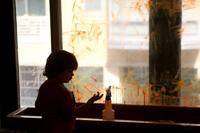
Atlanta’s High Museum, for example, initiated changes to its exhibits, admission fees and marketing strategy that tripled its non-white visitor numbers over two years, bringing its visitor demographics almost in line with that of the Atlanta metro area.
Bonnici said such undertakings aren’t always easy. “It is uncomfortable work, and it should be,” she said. “How do we create an environment where we lean into that?”
But the process can yield unexpected benefits, Bonnici said, as adapting to one group’s needs can make a space better for everyone. Take “curb-cuts,” the dips in the sidewalk to allow wheelchairs to easily move between the sidewalk and the street. Nowadays, “you can’t imagine a city now without curb-cuts,” Bonnici said, noting that strollers and bikes use them too. “It benefits everybody.”
A future of ‘co-creation’
In September, Bonnici will leave Madison for Boston, accompanying her partner as he takes a new job. She’ll shift to diversifying museum boardrooms and payrolls as one of the American Alliance of Museums’ 10 Diversity, Equity, Accessibility and Inclusion Fellows helping 50 institutions in five communities across the country “build inclusive cultures within their institutions that more accurately reflect the communities they serve.” A 2015 survey by the American Alliance of Museums found that 72% of all museum staff, as well as 84% of curators and leaders, were non-Hispanic white.
In an interview before the news of her move, Bonnici said museums need to strive for more than just a larger audience. The future of museums, she said, is “co-creation,” collaborating with “our full community.”
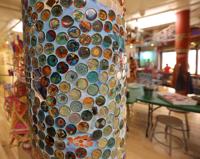
She recalled a project the Children’s Museum initiated as it prepared to open its current location at the corner of North Hamilton and North Pinckney streets just off the Capitol Square. Before the opening, staff sent 16,000 bottle caps to kids at every MMSD school, where each child decorated one cap for herself and sent one back to the museum. Staff took another 10,000 bottle caps with them on their “museum on the road” outreach trips. Students at Shabazz High School designed Wisconsin-themed mosaics using the bottle caps, and volunteers installed the mosaics on pillars in the museum’s second floor art classroom.
Ten years later, those children — now much bigger — still come in to look for their bottle caps, Bonnici said. “They have this deep personal connection to the museum because they had created something that then became a part of (it),” Bonnici said, “and I think that’s what we aspire to be: this place where people feel such a deep sense of value and belonging and that a part of themselves are here, too.”
Reduced prices are available to families of children with special needs
